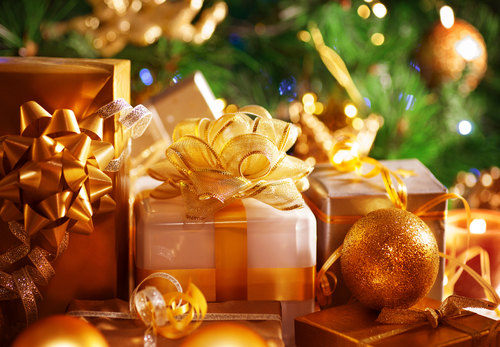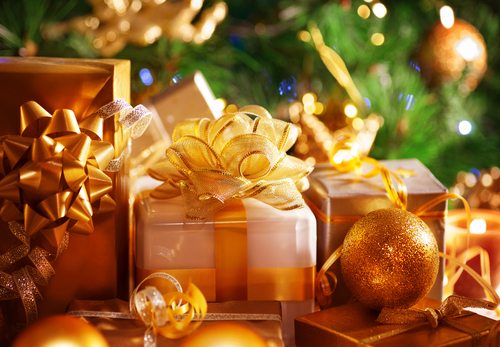
As much we decry the commercialization of the Christmas-Hannukah-Kwanzaa season, we need to keep in mind that the frantic search for the perfect gift is not at all a new phenomenon. Christmas gifts were an important feature of Henry VIII’s court. Every important person at court (and many not-so-important people) would give the King a gift for New Year’s and hope he’d reciprocate. Meanwhile, it was clear that the people of the time had as difficult a time choosing as we do today.
Gift to the King tried to incorporate a personal touch (what do you get the man who has everything?). Ladies would often give the King shirts they had embroidered themselves. In 1534, the Duke of Suffolk gave him “a book garnished with gold, having therein a clock.” Other gifts to Henry in 1534 included “a silver gilt compass, 69¾ oz., a goodly table of Hercules, a table of Our Lord, a tablet of gold with an antike face, a prymer of written hand in vellum, a goodly clock, an “esposier” of gold with a chain, a goodly table of St. Jerome, a tablet of gold with a device of Venus and Cupidoo, two ‘seviettes’ and a marmoset.”
The gifts given by the King feel a bit more rote, perhaps because he tended to make sure that people of similar rank received similar gifts, based primarily on value. For example, the Gift Roll in 1532 specifies that the Bishops of Canterbury, York, Durham, Carlisle, Winchester, Exeter, Hereford, Lincoln, London, Llandaff, Ely, Rochester and Bath all received “gilt cups, cruses, bowls, and goblets [made by] Cornelles, Freman, and Amadas; weight from 14 oz. to 25½ oz.,” while Dukes and Earls (specifically, the Lord Chancellor, the dukes of Richmond, Norfolk, and Suffolk, the lord marquis Exeter, the Lord Steward, the earls of Oxford, Northumberland, Westmoreland, Rutland, Wiltshire, Huntingdon, Sussex, Worcester, Derby, and Essex) received “gilt goblets, bowls, cruses, and cups, from 21 ozs. 1½ q. to 41½ oz.”
The biggest chuckle I get from the Gift Rolls is the difference in the general character of gifts that Henry gave Anne Boleyn before and after their marriage. When she was still a single woman, Henry poured on the romance with jewels: in 1529, he gave her nineteen diamonds for her head (Anne would weave jewels in her long hair when she wanted to make a special impact); two bracelets set with ten diamonds and eight pearls; two diamonds on two hearts for her head; twenty-one rubies artfully arranged into gold shaped like a rose; two borders of cloth of gold for the sleeves of a new gown, trimmed with ten diamonds and eight pearls….Then BLAM, once they were married, Henry started giving her more practical gifts: two gilt serving pots; a pair of silver wine flagons, decorated in the French style; twelve gilt bowls; three gilt salt shakers; twelve gilt spoons; two basins and ewers, a partially-gilt chafing dish; four candles…
Some things never change!
* * *
If you like my posts, you’ll love my books! My Seymour Saga trilogy tells the gripping story of the short-lived dynasty that shaped the Tudor Era. Jane the Quene skews romantic, The Path to Somerset is pure Game of Thrones (without the dragons), and The Boy King is a noir coming-of-age. Get them now through Amazon, Barnes & Noble, Kobo, and Apple, or even your local independent bookstore!

(PS Already read them? Did you love them? Then please review them – even just a stars rating! It makes a huge difference in helping new readers find them and would mean the world to me!)

At least he didn’t give her a vacuum cleaner.